HMS Warspite

Reviewed by Sean Hert

| HISTORY | ||||||||||||||||||||||||||
|
At long last, ship modelers can rejoice; there is finally a Queen Elizabeth class battleship available in 1/350 plastic! HMS Warspite was the second of five Queen Elizabeth class battleships. Warspite was laid down in 1912, and was completed in 1915, and fought at Jutland with 3 of her sisters in 1916. Warspite and her sisters continued to serve long after World War One had ended. Each member received extensive refits in that time, each ship becoming unique in appearance by World War Two; Warspite having major refit/reconstruction in 1937, and another refit in the United States, during 1941. The Queen Elizabeths are armed with 8 15" guns, in four twin turrets mounted fore and aft in an "A-B" "X-Y" configuration. The number of 6" secondary guns, both deck mounted and casemated, changed over the course of the many refits, as did the anti-aircraft fit. These 35,000ton battleships also had 21-inch underwater torpedo tubes as built; these too were removed in the inter-war period. Warspite saw intense action in World War Two, from 1939 until 1944, going into reserve in 1945 and after attempts to convert her into a museum ship failed, scrapped in 1950. Warspite earned the highest number of overall battle awards in the Royal Navy- both in World War Two, and of all time. |
||||||||||||||||||||||||||
| HULL PARTS | ||||||||||||||||||||||||||
|
Warspite is in Academy's standard two-part hull, split down the centerline along the keel. The hull halves are detailed with nice portholes with gutters (eyebrows), fairleads, and the correct number of anchor hawseholes. The hull features a waterline option, a scribed line running the length of the hull on the waterline. This will require cutting the hull along this line. There are three bulkhead stiffeners on sprue B for hull reinforcement of the waterline option; a design feature seen previously on Academy kits. There are no raised lines to delineate the waterline on the hull. The torpedo bulge added in the 1937 refit is nicely detailed, with access hatches, drains and bilge keel. Academy has done a good job recreating the complex shape of the bulge, with the multiple curves fore/aft and on the bottom. The slide mold used for the lower bulge has left a seam, causing a slight marring of the hull. This seam is difficult to feel, and should prove simple to fix (if even necessary). The bottom of the left side of the hull is slightly warped, but assembly should straighten this out. Many sources disagree about the dimensional particulars of HMS Warspite at this time, and the complex hull shape makes accurate measurements difficult. The easier to measure waterline length was 54.8cm (21.57"), which works to around 629' 4". Beam was more difficult, but seems about 9.1cm (3.6"), or about 105'. |
||||||||||||||||||||||||||
 |
||||||||||||||||||||||||||
|
||||||||||||||||||||||||||
| SPRUE B | ||||||||||||||||||||||||||
|
Sprue B has the three main deck pieces, the prop shafts, sternwalk, and the interior bulkheads for the two-part hull. There are also some 20mm tubs with relatively thick splinter shields. The decks do not have bollards molded on; rather, each bollard is a separate part on Sprue F. There is basic planking detail, in an alternating pattern of every other plank. The forecastle piece has a pronounced camber which is more of a slope from a central point than the normal curvature seen. The extreme starboard anchor chainway is missing the deck pipe to the chain locker. The midships piece has the crossdeck seaplane catapult molded on, and is basic in its appearance. The solid shield which runs the border of the twin Mark XIX 4" QF guns is thick in appearance, similar to the 20mm tubs. The breakwater looks good, as do the prop shafts and skegs. The parts for the admiral's sternwalk appear a bit too thick- something of a theme with Academy kits. |
||||||||||||||||||||||||||
 |
||||||||||||||||||||||||||
|
||||||||||||||||||||||||||
| SPRUE C | ||||||||||||||||||||||||||
|
Sprue C is mostly concerned with the amidships and after superstructure areas of the 01 level and above. That said, there are also some pre-formed plastic anchor chains here. These are interesting, and will look much better than molded on chains. The bulkheads have some good details, the watertight doors look very nice. The two halves of the funnel are plain, but the included screen cap looks good. The shape of the after 15" director is good, but the openings and vision ports are lacking. There are some rudimentary details for the seaplane hangar. |
||||||||||||||||||||||||||
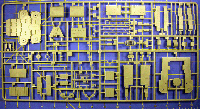 |
||||||||||||||||||||||||||
|
||||||||||||||||||||||||||
| SPRUE D | ||||||||||||||||||||||||||
|
The sprue is mostly concerned with the forward superstructure, including the distinctive armored tower bridge of the refit Queen Elizabeths. The parts that make up the tower bridge have beveled inside corners to aid in assembly, but there is no other internal structure; alignment could be an issue. The bridge levels have the wind deflectors molded on, and look good. The upper level has some molded-in stairs leading down, which will be too thick to some eyes. There are more 20mm tubs; the shields continue to be thick. The main battery director looks ok, but the Type 284 radars are very simplified. The parts to assemble the mainmast are here as well, including the "starfish" and the Type 273 lantern radar. The lantern is split in two halves, so aligning the panes will take some care. |
||||||||||||||||||||||||||
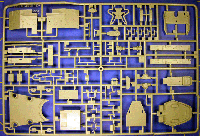 |
||||||||||||||||||||||||||
|
||||||||||||||||||||||||||
| SPRUE E x2 | ||||||||||||||||||||||||||
|
This large sprue has a variety of parts and assemblies on it for use in many areas of Warspite. This includes the 3-part pedestals for the display, the ship's propellers and rudder, the seaplane crane, as well as the casemate SP 6"/45 Mark XII guns, the twin Mark XIX mounts, and the star attractions; the twin 15" main guns of this battleship. The boom of the crane is slide- molded as a solid part, with the gantry being a two-piece affair elsewhere on this same sprue. The boom has raised detail for the individual lattices, but does not deter from the fact this is a large, solid, piece of plastic. Academy choosing to include a photoetched alternative to this part was most likely a good decision. Each Sprue E has 2 props and one rudder, bringing the total included to the proper 4 and 2. The props do not appear to have the correct blade shape or pitch. The rudder is close in correct appearance, being a bit off in the curvature of the lower half. The casemates look good, with the rubber barrel bloomers molded in place. The vision ports for the pointer and layer are indicated with indentations to the front of the casement, but are not over done. The 6" barrels have open muzzles, and look to have a good shape. These barrels include the counterweights added to help aid in handling. The Mark XIX mounts are in two pieces, a base and gunshield. The gunshield is plain, with other a faint outline around the vision ports. The base does have simplified fuse setters to each side, one for each gun. There are two styles of 15" turret included; one styles for turrets "A" and "Y", and one for "B" and "X". The turret shapes look well done, and have the overlapping plate armor expected on this turrets. The rangefinders are molded separately. There is no rivet detail anywhere on these turrets, and the molded on ladders are too far toward the back. The bottom of each turret is keyed, so the mains will be re-positionable after assembly. The 20mm tubs are molded separately, and have the same thick walls as seen on D. The rangefinder hoods for these turrets are missing some slight details, and the 30' rangefinders for "B" and "X" turrets are too thin. The 15" barrels have a little flash on the open muzzles, but otherwise look good. The mounting ring at the base of the barrel, where it meets the bloomer part, is maybe just a touch oversized. The bloomers all look good, albeit they are each identical. |
||||||||||||||||||||||||||
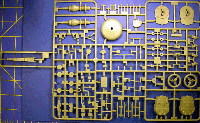 |
||||||||||||||||||||||||||
|
||||||||||||||||||||||||||
|
The barrel and bloomer parts mate well, and look good together. Unfortunately, when placed into the turret, the guns appear at maximum depression. Some careful fiddling with these parts or scratchbuilding will be required to pose these guns with any sort of elevation. |
||||||||||||||||||||||||||
|
||||||||||||||||||||||||||
| SPRUE F x2 | ||||||||||||||||||||||||||
|
F is the final sprue of Warspite, and also has a large variety fittings and items upon it. These fittings very from nicely detailed to fairly plain, with most being acceptable in appearance. The paravanes are very nice, some of the nicest ones in plastic, as are the 20mm Oerlikons. The 8-barrel pom-poms are good, but the barrels look a bit proud and brutish. The underside of the base has some ejector pin marks, but these should be mostly invisible. There are also the many individual bollards and bitts to be placed in pairs around the decks parts on this sprue, as well as the various capstans and windlasses. The HCAS are acceptable, and the Type 285 Yagi antennas are solid triangles, par for the course, for being molded in plastic. The twin QF 4" Mk XVI guns have a good shape, and the breech and breech block look good. The ship's boats are inconsistent; the 45' fast motor boat and motor launches are pretty good, with the fast motor boat missing a few windows. Both of the 45' hulls have strakes and keels. The 35' motor boat, however, is marred by sink marks on both the hull and deck parts. The Supermarine Walrus is also inconsistent in detail. Where the fuselage has engraved panel lines- and perhaps should not- the wings and tail are smooth. The exposed Pegasus radial engine has eight cylinder heads, where it should have nine. The four-bladed propeller is also somewhat basic. |
||||||||||||||||||||||||||
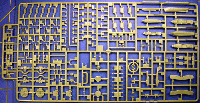 |
||||||||||||||||||||||||||
|
||||||||||||||||||||||||||
| DISPLAY BASE OPTIONS | ||||||||||||||||||||||||||
|
A sculpted plastic base is included. |
||||||||||||||||||||||||||
|
||||||||||||||||||||||||||
| PHOTOETCH | ||||||||||||||||||||||||||
|
A fret of relief-etched stainless steel photoetch is included. This fret offers an upgraded replacement for the amidships cranes on Warspite. |
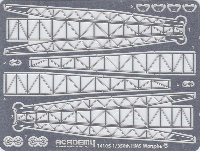 |
|||||||||||||||||||||||||
| DECAL | ||||||||||||||||||||||||||
|
This decal set provides the modeller with many roundels and markings for the Walrus, two styles of Royal Navy White Ensigns, and three Union Jacks. |
 |
|||||||||||||||||||||||||
| INSTRUCTIONS | ||||||||||||||||||||||||||
|
The instructions consist of a single sheet with multiple folds; a single page of info and 7 pages of instructions. This is no text; the instructions rely on solely on graphics and pictographs- which should not be an issue for most modelers. As always, read through the directions, and each step, before construction. Academy has opted not to include large, overscale plastic railings, as they had with previous ship offerings. There is an additional sheet with a sprue listing and painting instructions. Academy has 12 different paint types referenced, but not all colors have a recommended match. The directions for the flag decal placement are misleading; all those flags would not be flying at the same time. There are large numbers of unused parts listed, but these appear to be mainly extra parts left over from the doubling of included sprues. |
||||||||||||||||||||||||||
|
||||||||||||||||||||||||||
| CONCLUSIONS | ||||||||||||||||||||||||||


Academy has beaten the competition in releasing Warspite in September. Trumpeter has announced a 1/350 Queen Elizabeth, but being first to market is a great advantage, as well as having an MSRP of $69.00. Academy's economic alternative, while not quite hitting the cutting edge of detail availble with current technology and research, doesn't seem to have any serious issues. Overall, it's a good kit. While not without its flaws, most of which can easily be forgiven by this kit's great price. These flaws will mainly be of concern to the higher end, detail-fixated modelers; the regular builder will be able to buy this model and really enjoy both the build and the finished product- it will look like an HMS Warspite when finished. To wit- this kit should prove to be just fine for most of the modelling public, and a gem in the rough for the aftermarket crowd. Thanks to MRC for the pre-release review sample. These kits should be showing up in your local hobby shops soon (September 2011). MRC is the US importer for Academy model kits. |
||||||||||||||||||||||||||
